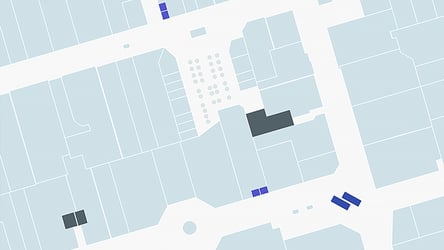Our dependence on maps has grown to the extent we cannot navigate without them. We've gone from paper maps to digitized maps on devices that depend on GPS. This is all great for the outside world, but what's taking place inside corporate buildings? Thanks to indoor office mapping and advances in indoor positioning systems, enterprise-scale indoor intelligence is now possible, providing unprecedented visibility into these complex facilities.
Here are 3 benefits for organizations to consider with indoor maps:
Workplace Health & Safety
According to the Occupational Safety and Health Administration (OSHA), employers are required to implement preventative measures to ensure workers are not exposed to conditions which could be harmful to their health and safety while working. Failure to ensure a safe workplace can lead to liability issues, including fines and penalties, and in serious cases, criminal prosecution.
For organizations planning their return-to-work measures, indoor maps and indoor positioning can provide the peace of mind you need to bring back your workforce safely by using the following features:
- Using digital contact tracing to quickly identify potential transmission of COVID and notify others with risk of exposure, helping isolate infections before they spread.
- Create seating plans that comply with physical distancing protocols, or using desking booking technology to alternate teams back into the office.
- Identify surface areas that may require cleaning as a result of exposure or high traffic. This can help organizations cut costs in having maintenance teams focus on certain areas of your building, and not clean the entire building each time.
Intelligent Navigation
Maps alone can be a useful navigation tool, but they become even more powerful with blue dot technology and indoor navigation.
When you combine dynamic layer-based indoor maps with the power of IPS technology to provide your users with a blue dot navigation experience, you're enabling them to see their live location on a map and find their way through your space quickly and efficiently. Intelligent indoor navigation also enables people to search for, and navigate to, specific points of interest.
Beyond helping to create a smoother experience, this ultimately helps reduce stress and anxiety for people who are in your space for the first time. When your users have a clear path and can locate and navigate to their destinations on time, that improved experience will be associated with your organization as a whole. Similarly, this technology can also support intelligent wayfinding applications like route accessibility, making your space more navigable for those with different abilities.
Workplace Optimization & Building Utilization
When it comes to real estate investments, your operations team needs to understand how people are interacting with your space. Using indoor intelligence technologies and indoor analytics data visualizations like heatmaps and dendrograms, organizations can assess how people move through buildings and where they linger most. This is especially important when you are considering whether to downsize or increase existing space. By equipping your operations teams with the comprehensive data that they need to make meaningful improvements to space utilization and allocate resources more effectively.
Indoor intelligence technology can support workplace optimization and improve building utilization in three key areas:
- Give operations teams insight into which areas are over- and under-utilized. This gives organizations the information they need to adjust physical space usage when they grow or downsize.
- Empower facilities management teams to use Internet of Things (IoT) sensors and automation to control lighting and HVAC systems. This can create significant cost savings in utility bills when energy usage is minimized in under-occupied spaces.
- Optimize room booking, usage, and energy expenditures. By integrating map-enabled applications with your calendar and room booking systems, organizations can use maps to visualize meeting rooms and track usage. Using occupancy sensors, facilities and operations teams can track how and when these rooms are being utilized and adjust cleaning and energy usage efficiently.
In the midst of the COVID-19 pandemic, the nature of workplaces and corporate campuses is in flux, and the only certainty is uncertainty. However, with challenges come unparalleled opportunities. We are here to help you identify your organization's opportunities to create a safe and comfortable return-to-work for your teams. Contact our team of experts today to find out how Inpixon can help.

.png)

.png)

.png?width=760&height=550&name=Wayfinding%20(1).png)





